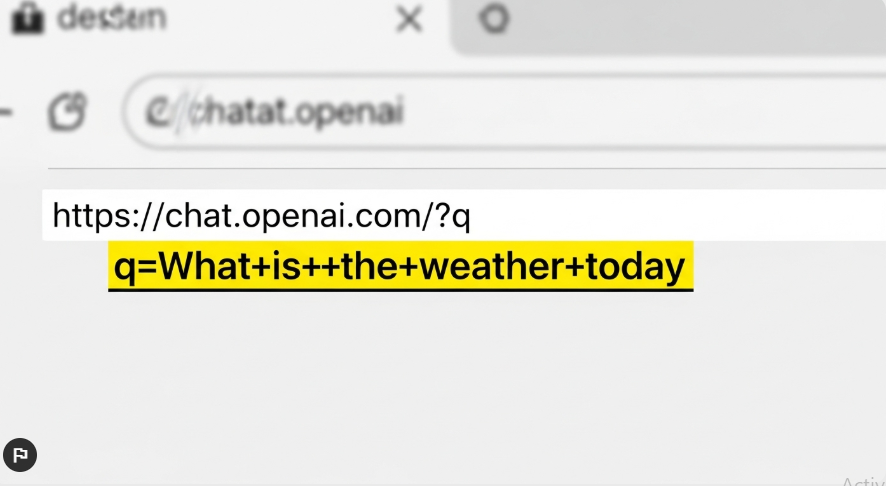Sending a prompt to ChatGPT using a query string can save time and simplify tasks. A query string is a part of a URL that passes data to a web application. This overview explains how to use query strings to send a prompt to ChatGPT.
What Is a Query String?
A query string is a section of a URL that sends information to a website or application. It starts with a question mark (?) and includes key-value pairs, like q=your+prompt. For ChatGPT, query strings can pre-fill a prompt in the chat interface, making it easier to start a conversation without typing.
Why Use Query Strings with ChatGPT?
Query strings help users:
- Save time by pre-filling prompts.
- Automate repetitive tasks.
- Share specific prompts via links.
- Integrate ChatGPT into apps or websites.

How to Create a Query String for ChatGPT
To send a prompt to ChatGPT via a query string, follow these steps. This method works for the web version of ChatGPT (as of July 2025).
Step 1: Understand the URL Structure
ChatGPT’s web interface supports query strings in a specific format. The base URL is https://chat.openai.com/. You add parameters like model (to choose the AI model) and q (for the prompt). For example:
- https://chat.openai.com/?model=gpt-4o&q=What+is+Python
Step 2: Choose the Right Parameters
The key parameters are:
- model: Specifies the ChatGPT model (e.g., gpt-4o or gpt-3.5).
- q: The prompt you want ChatGPT to process. Replace spaces with plus signs (+) or encode special characters.
Example: To ask about Python, use q=What+is+Python.
Step 3: Encode the Prompt
Spaces and special characters in the prompt must be URL-encoded:
- Replace spaces with + or %20.
- Use online tools like URL Encoder for complex prompts.
For example, “How to code in Python?” becomes q=How+to+code+in+Python%3F.
Step 4: Build the Full URL
Combine the base URL and parameters. For example:
- https://chat.openai.com/?model=gpt-4o&q=How+to+code+in+Python%3F
When users click this link, ChatGPT opens with the prompt pre-filled.
Step 5: Test the URL
Open the URL in a browser where you’re logged into ChatGPT. The prompt should appear in the text box. Note: You must be logged in for the query string to work. If not, ChatGPT may redirect to the login page.
Practical Examples of Query Strings for ChatGPT
Here are real-world examples of query strings for different use cases:
- Learning: https://chat.openai.com/?q=Explain+machine+learning+in+simple+terms
- Coding: https://chat.openai.com/?model=gpt-4o&q=Write+a+Python+function+to+calculate+factorial
- Business: https://chat.openai.com/?q=Create+a+marketing+plan+for+a+small+business
- Fun: https://chat.openai.com/?q=Tell+me+a+joke+about+programming
Common Questions from Users
Based on Google’s “People Also Ask” and “Related Searches,” here are answers to frequent questions:
Can You Pass Prompts to ChatGPT via API?
Yes, but this guide focuses on the web interface. For API use, you need an OpenAI API key. Send prompts via a POST request with JSON data. Visit x.ai/api for details.
Does ChatGPT Support Query Strings for Custom GPTs?
Currently, custom GPTs don’t officially support query strings for pre-filled prompts. However, you can use the standard ChatGPT URL format for general prompts.
Why Doesn’t My Query String Work?
Common issues include:
- Not being logged into ChatGPT.
- Incorrect URL encoding (e.g., missing + for spaces).
- Using an outdated model name (e.g., gpt-3 instead of gpt-4o).
- Browser extensions or redirects interfering.
Fix: Double-check the URL, log in, and test in an incognito window.
How Can I Automate Query Strings?
Use query strings in:
- Browser bookmarks for quick access.
- Chrome extensions to redirect searches to ChatGPT.
- Website links to share pre-filled prompts with users.

Best Practices for SEO and User-Friendly Content
To make your query strings effective and keep your content ranking well:
- Be Specific: Write clear, detailed prompts for better responses.
- Test Models: Use gpt-4o for complex tasks; gpt-3.5 for simpler ones.
- Keep It Simple: Avoid long prompts to prevent URL errors.
- Check Compatibility: Ensure the URL works across browsers (Chrome, Firefox, Safari).
- Update Regularly: Verify model names as OpenAI updates ChatGPT.
NLP Terms and Themes for SEO
Based on top-ranking pages, key NLP terms include:
- Query string
- URL parameters
- ChatGPT prompt
- URL encoding
- API integration
- Pre-filled prompt
- Web automation
Themes focus on automation, user efficiency, and integrating ChatGPT into workflows. User questions often center on “how to automate prompts,” “URL query string format,” and “ChatGPT API usage.”
Troubleshooting Query String Issues
If your query string fails:
- Login Issues: Ensure you’re signed into ChatGPT.
- Encoding Errors: Use a URL encoder for special characters.
- Model Availability: Confirm the model (e.g., gpt-4o) is available for your account.
- Browser Problems: Clear cache or try a different browser.
Why This Method Matters
Using query strings with ChatGPT saves time and improves productivity. It’s ideal for developers building apps, educators sharing prompts, or anyone automating tasks. By following this guide, you can create reliable, user-friendly URLs that work in 2025 and beyond.
Call to Action: Try building your own query string now! Start with a simple prompt like q=What+is+AI and test it at https://chat.openai.com/. Share your results or ask questions in the comments below.
